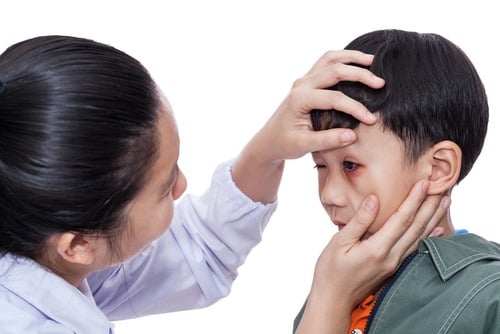First Aid for Eye Emergencies: What to Include in Your Home Kit
Is your first aid kit prepared to handle eye emergencies? Learn about eye injury first aid & when to call the eye doctor for immediate care.
First Aid for Eye Emergencies: What to Include in Your Home Kit
In the blink of an eye, your vision or your child’s vision could be in grave danger due to an unforeseen accident.
When an emergency arises from any number of situations and causes, will your first aid kit have the proper items needed to handle an eye injury?
It’s OK if you answered no, as it’s common for most at-home first aid kits to only be stocked and ready for minor cuts, scrapes and sprains. But when an eye emergency occurs, it’s important to have the necessary first aid and to know what to do.
Ensuring you’re prepared for the unexpected can save precious time and mean the difference between possible blindness or vision issues and a speedy recovery.
Let’s run down what to add to your home’s first aid kit to guarantee it’s prepped if an eye injury would happen. We’ll also discuss when you should call your eye doctor due to the severity of the injury.
Eye Injury First Aid
The three most important things to have in your first aid kit for eye emergencies are:
- A rigid eye shield
- Commercial eyewash (that is not expired)
- Activated/instant cold compress
Eye Injuries from Chemical Burns
Chemical burns in the eye(s) can easily happen at home with exposure to cleaning products, drain cleaners, fertilizers, nail polish remover and other substances, including vinegar.
Whenever eyes come in contact with chemicals, you should immediately:
- Flush the eye with water *If a contact lens is in the eye, flush over the lens
- Hold the eye under a faucet or shower, or pour water into the eye from a clean container. *The eye should remain open wide during flushing
- Flush the eye for a total of 15 minutes
- DO NOT bandage the eye
- CONTACT your optometrist immediately after flushing
Eye Injuries from Cuts and Punctures
Perhaps the most common eye injury – because they can happen spontaneously and just about anywhere – cuts and punctures to the eyes and eyelids should be treated promptly:
- Cover the injured eye with a rigid shield without pressure. *Secure the shield to the eyebrow and the cheekbone without putting pressure on the eye
- DO NOT wash out the eye with any liquid
- DO NOT try to remove an object from the eye if something remains lodged in there from the injury
- CONTACT your optometrist immediately after applying the shield
Eye Injuries from Sudden Impacts
Colliding with another person or object, whether in a sporting event or by sheer accident, can mean significant trauma to the eye. If a blow to the eye occurs:
- Immediately apply a cold compress without pressure
- Continuously monitor the area around the eye
- CONTACT your optometrist immediately if you experience:
- Pain in or around the eye
- Blurry vision
- One eye sticking out more than the other
- Blood inside the eye
- Discoloration around the eye (black eye) *This can mean internal eye damage
First Aid for Eye Irritation
When specks of dust, sand and dirt get caught in the eye, there are right and wrong ways to handle this eye annoyance:
- First of all: DO NOT rub the eye
- Allow natural tears to work the speck out
- If your natural tears don’t remove the irritation, try using commercial eyewash
- Lift the upper eyelid outward and look down over the lower lid to try to loosen or move the speck
- DO NOT attempt to use tweezers or another tool to try and remove the speck
- CONTACT your optometrist if the speck doesn’t wash out
Experiencing any of the follow symptoms? Call your optometrist immediately!
No two eye injuries are exactly alike. Because of this, symptoms can vary.
If you have something in your eye that you’ve been unable to remove on your own, or if you’re experiencing any of the following symptoms, you should seek emergency eye care from your optometrist right away.
*Eye emergencies are better treated by an eye doctor than by urgent care or the emergency room (ER). Contacting your optometrist first will save you valuable time and provide you better assistance.
Signs of an eye injury and symptoms that require emergency service include:
- Sudden loss of vision
- Sudden double vision
- Sudden redness/irritation/pain in the eye
- Sudden burning or stinging
- Different sized pupils
- One eye moving differently than the other
- One eye bulging or sticking out
- Decreased vision
- Severe light sensitivity
- Severe itching
- Discharge from the eye
- Bleeding from the eye
- Blood in the white part of the eye
- Bruising or swelling around the eye
- New onset flashes and/or floaters
- Foreign body in the eye (especially metal or chemicals)
- New or severe headaches with sensitive vision
In any eye emergency situation, the absolute best thing to do is seek care from an optometrist immediately.
Emergency Eye Care: Call 888-393-3911
24-Hour Emergency Eye Care with the Experts at iCare Vision
If you or a loved one have sustained an eye injury, don’t wait to seek medical attention – your vision depends on immediate, professional help.
Our team is highly experienced in a wide-array of acute and vision-threatening eye emergencies, and we’re available anytime, day or night.
Emergency Eye Care: Call 888-393-3911
While waiting for our professional help, read more about eye emergencies, including what NOT to do before we’re able to see you:

